Zacchia da Vezzano's Nativity: history of the altarpiece stolen and found, in part, in pieces
“The remaining parts have not yet reappeared, but the dissemination of the photograph of the painting will hopefully lead to the complete recovery of it so that it can be reassembled in the church for which it was executed.” This hope closed an article that appeared in 1922 in Emporium magazine, which gave an account of the discovery of several paintings that had been stolen in the previous months. One of these paintings was the Nativity by Zacchia da Vezzano (real name Hezekiah, documented in Lucca from 1510 to 1561), a painter who, as the name suggests, was originally from Vezzano Ligure, a village halfway between Sarzana and La Spezia. An artist also known today as Zacchia the Elder, a nickname given to him by Luigi Lanzi to distinguish him from a descendant, also a painter, namely Lorenzo Zacchia (called Zacchia the Younger). The Nativity (actually, more properly, anAdoration of the Shepherds) had been stolen in 1921 from the altar that housed it, inside the church of Sant’Agostino in Pietrasanta, now suspended for worship and used as an exhibition venue. Unhappily, the thieves had the bad idea of dismembering an altarpiece that had survived four centuries of history unscathed, having been painted in 1519: they hoped to be able to place it better on the market, because fragments sold individually are less easily traced, because, on the contrary, the intact altarpiece would be easily identified since it is a well-known work, and also because, in their intentions, the individual pieces would have brought in greater profits than that from the sale of the whole altarpiece.
In 1922 three fragments were traced to a private individual in Milan. In the most important one we glimpse the figure of Saint Joseph, from head to shoulders, and that of the shepherd standing behind him. The remaining two fragments, on the other hand, house two angels in flight, which formerly occupied the upper register of the canvas. The painting today is known only through a period black-and-white photograph. For, unfortunately, the rest of the altarpiece was never found again, despite the article’s hopes for a complete recovery.
For years, the three fragments lay hospitalized on the premises of the Lombardy Superintendency, waiting to be restored and to leave for Pietrasanta. Consider that in 1997, when Federico Zeri was editing the catalog raisonné of the Pinacoteca di Brera, the pieces of Zacchia da Vezzano’s altarpiece found in 1922 were still stored in the Milanese museum’s deposits. However, the great scholar was convinced that the painting’s central scene, with the kneeling Madonna in adoration of the Child and the shepherds arriving further back, still existed. Perhaps in the collection of some private individual no less unscrupulous than the thieves. In any case, in the end the fragments, tracked down in the Braidense deposits, were handed over to the Superintendence of Pisa, subjected to the restorations they needed given also the “mediocre conditions of preservation,” as Zeri himself pointed out in 1997, and returned to the church of Sant’Agostino, where today they can be admired, protected by a glass case, in the first right chapel of the church. Of course, the hope is that, despite the fact that almost 100 years have now passed since the theft, the rest of Zacchia’s canvas will also be found sooner or later.
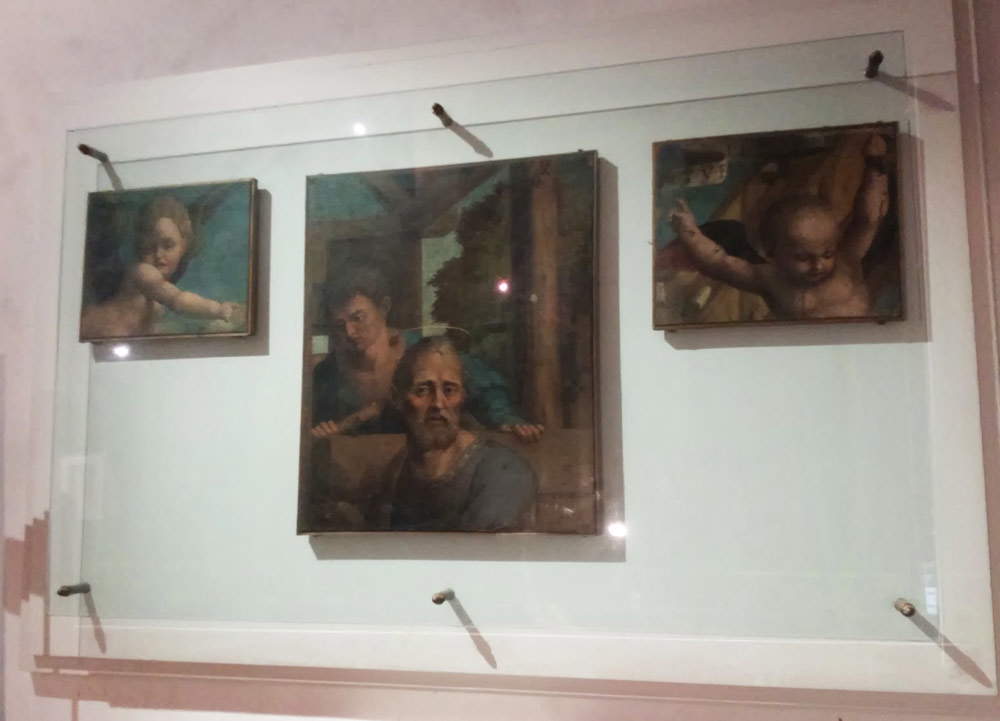 |
| Zacchia da Vezzano, Nativity Fragments (1519; Angel in Flight: oil and tempera on canvas, 36 x 44 cm; Angel in Flight with Inscription Fragment: oil and tempera on canvas, 33.7 x 41 cm; St. Joseph and Shepherd: oil and tempera on canvas, 74 x 62 cm; Pietrasanta, Sant’Agostino) |
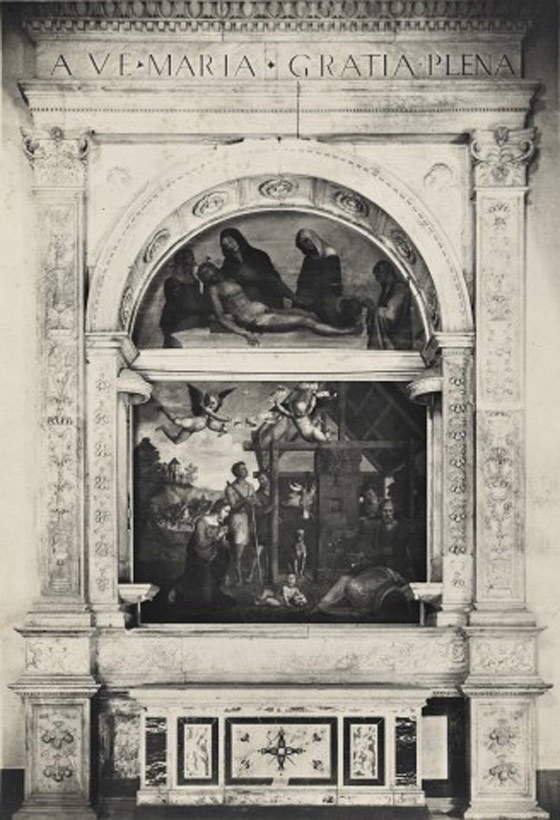 |
| Zacchia da Vezzano’s Nativity in the only photo of it before it was stolen (photo Brogi). |
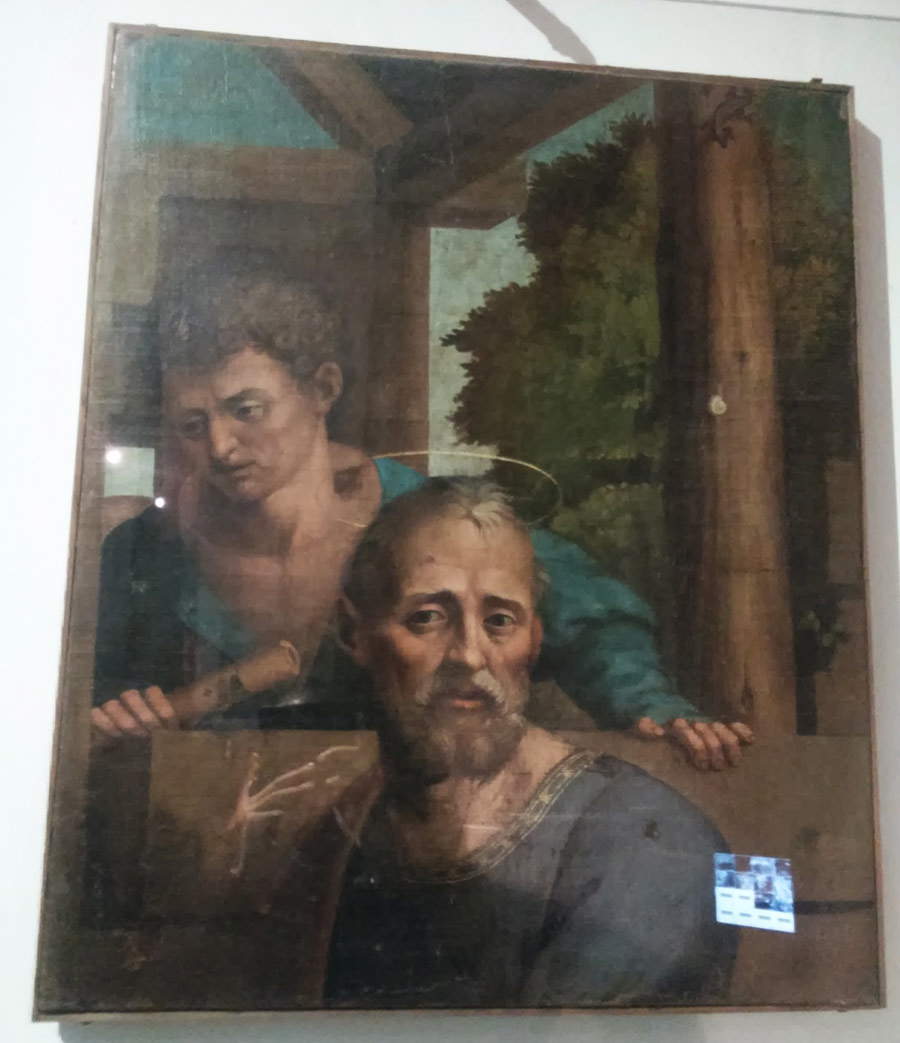 |
| ZThe main fragment (Saint Joseph and the shepherd). |
Also because this is a fundamental painting in the artistic career of this Ligurian painter, but Lucchese by adoption: it is in fact his first documented work. One of the most detailed descriptions of the Nativity was provided, in 1871, by the Lucchese art historian Enrico Ridolfi, who that year had written a booklet entirely dedicated to Zacchia and entitled Della patria e delle opere di Zacchia il Vecchio, pittore (a curiosity: editor of the volume was the Montignosino historian Giovanni Sforza, who had dedicated it to Alessandro D’Ancona, on the occasion of the wedding of the well-known scholar and man of letters to Adele Nissim). Here is how Ridolfi had described the work: “this is the beautiful altarpiece representing the Nativity, painted by Zacchia for the church of the Augustinians in Pietrasanta, and bearing his figure and the date MDXIX. It is placed in the chapel of the Annunziata, where in 1512 a confraternity of women that was established there erected the splendid marble altar that can be seen there, adorned with exquisite carved and gilded bas-reliefs. Full of humility, tenderness and Raphaelesque grace is the attitude of the Virgin adoring the born child, drawn and moved with beautiful grace. Dignified and tranquil is the figure of St. Joseph, in varied and just attitudes of admiration the hasty shepherds; enchanting in gracefulness of form and movement are the little angels, hovering above the clouds rejoicing in the born Messiah. The village, too, and that group of horsemen on bizarre palafreni, which can be seen far away, recall Raphael. The coloring of it is somewhat clouded by grime and bad restoration, but still it proves vague and harmonious. Finally, it is a precious little picture that falls in love with you and makes you quickly bring to mind the name of those two most gentle painters of sacred instories.”
The two “gentilissimi pittori di sacre istorie” to whom Ridolfi refers are Raphael and Friar Bartholomew: it is in fact in the groove of the mature classicist Renaissance that Zacchia’s training developed. The painter, a pupil of a local artist, Agostino Marti, had presumably made trips to Florence where, in addition to the works of the aforementioned Raphael and Fra’ Bartolomeo, he had been able to observe at close quarters the paintings of other important artists of the time, such as Perugino, Michelangelo and Ridolfo del Ghirlandaio. All these experiences add up in the Nativity, which from the outset appears, as a whole, as a Perugino-derived composition: the scene evenly divided between the hut on the right and the landscape on the left, the tree on one side balancing the elements, the Madonna and St. Joseph at a distance and in a symmetrical position with the Child in the center, are all elements that are punctually matched in Perugino’s works (the famous Adoration of the Magi in the National Gallery of Umbria, the one in the predella of the Polyptych of St. Peter, the Nativity in the Collegio del Cambio), to which the general setting of Zacchia’s work seems to refer.
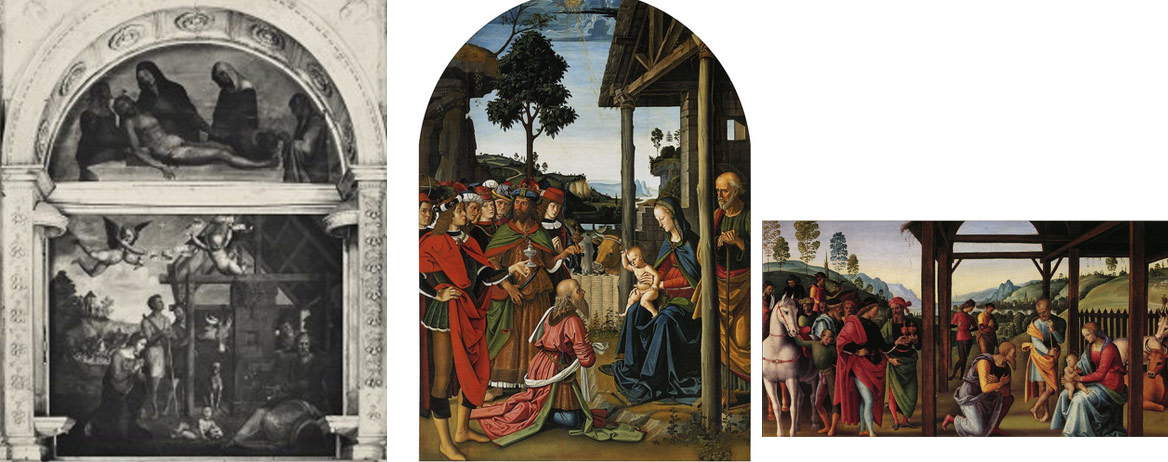 |
| Comparison between Zacchia’s Nativity and Perugino’s Adoration of the Magi (Perugia, National Gallery of Umbria) and Perugino’s Adoration of the Magi in the predella of the Polyptych of St. Peter (Paris, Louvre) |
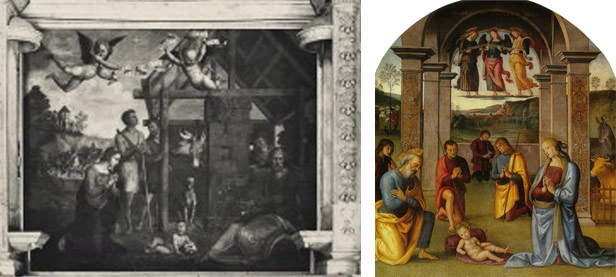 |
| Comparison between Zacchia’s Nativity and that of Perugino (Perugia, Collegio del Cambio) |
To the Perugino model, however, our artist brings some updates resulting, as anticipated, from his in-depth reading of the great masters of the mature Renaissance. The little angels fluttering above seem to derive from Fra Bartolomeo (the one on the left is almost identical to the one we can observe in the Carondelet altarpiece painted by the Florentine friar), while the Madonna, thus kneeling in profile, resembles, as noted by art historian John Pope-Hennessy in an article in Burlington Magazine devoted to the two Zacchia, to the kneeling Magdalene in Ridolfo’s Madonna and Child with Saints preserved in Florence’s Galleria dell’Accademia, but also to the female figure that appears in theAssumption in Prato Cathedral. And again to Ridolfo del Ghirlandaio refers the bizarre pose of Baby Jesus, lying down but about to rise and already with his back elevated: it is similar to the Child who appears in the center of Ridolfo’s Tondo Beit, now in Manchester. All Raphaelesque, on the other hand, are the grace,elegance and attitudes of the protagonists, as indeed Ridolfi already noted in his book.
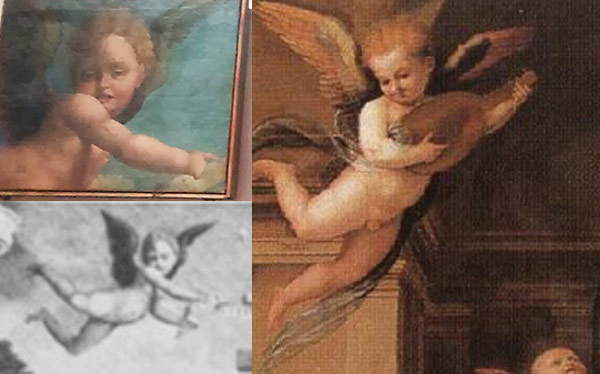 |
| Comparison between Zacchia’s angel (upper left in the fragment and lower left whole in the period photo) and that of Brother Bartholomew in the Carondelet altarpiece (Besançon, Cathedral) |
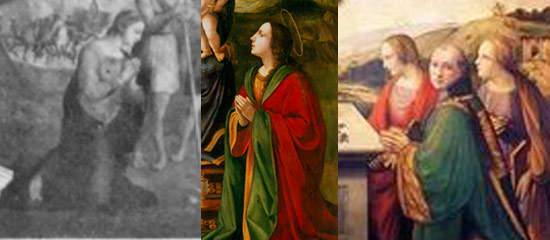 |
| Comparison of Zacchia’s Madonna, Ridolfo del Ghirlandaio’s Magdalene in the Madonna and Child with Saints (Florence, Accademia Gallery) and the woman in theAssumption (Prato, Cathedral) |
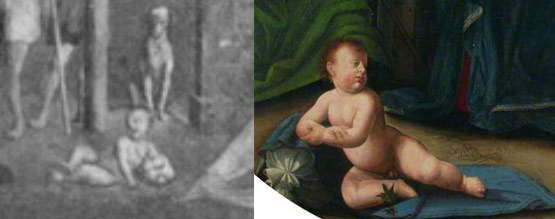 |
| Comparison between Zacchia’s Child and Ridolfo del Ghirlandaio’s Child in the Beit Tondo (Manchester, Art Gallery) |
Of course: being able to see the altarpiece, as a whole, would have allowed a better appreciation of these continuous references, the quotations, the great refinement of Zacchia’s brushwork. It is possible to partially remedy this by looking at the surviving fragments, as well as at the two splendid altarpieces by Zacchia preserved not far from Pietrasanta, in Lucca, in the Museo Nazionale di Villa Guinigi, anAssumption and another Nativity not far, in manner, composition, balance and influences, from the Versilian one. While it is to be hoped that the rest of the canvas may sooner or later return to Pietrasanta, a visit to the church of Sant’Agostino is more than recommended for art lovers visiting the Versilia town. It may then be argued that many times the layouts of temporary exhibitions are highly impactful and overshadow the works in the church: but this, while preventing one from appreciating the integrity of the environment, does not detract from the value of the works preserved, and the three pieces of the Zacchia altarpiece.
Reference bibliography
- Federico Zeri (ed.), Pinacoteca di Brera: addenda and general apparatus, Mondadori Electa, 1997
- Patrizia Giusti Maccari, Ripercorrendo Zacchia il Vecchio in Momus, V-VI, 1996, pp. 39-51
- Clara Baracchini, Severina Russo, Arte sacra nella Versilia medicea: il culto e gli arredi, Centro Di, 1995
- Ernesto Borelli, In the Sign of Fra´ Bartolomeo. Painters of the sixteenth century in Lucca, Pacini Fazzi, 1984
- John Pope-Hennessy, Zacchia il Vecchio and Lorenzo Zacchia in The Burlington Magazine, CDXXII, 1938, pp. 213-223
Warning: the translation into English of the original Italian article was created using automatic tools. We undertake to review all articles, but we do not guarantee the total absence of inaccuracies in the translation due to the program. You can find the original by clicking on the ITA button. If you find any mistake,please contact us.



























